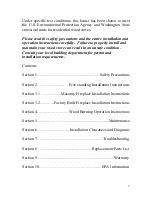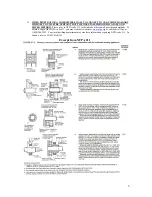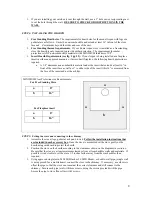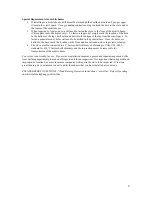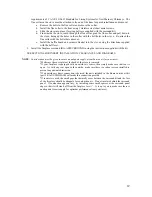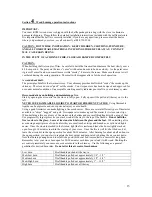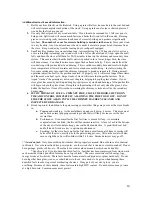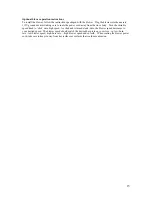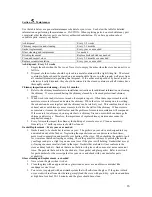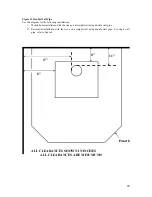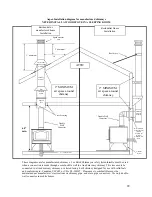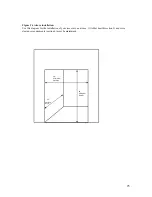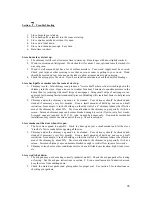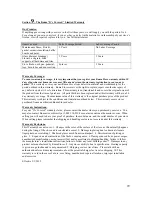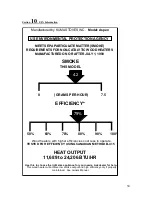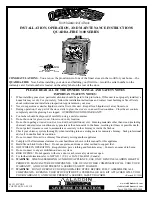
17
4.
Never build a fire against the glass.
5.
When closing the door be sure that no pieces of wood are protruding from the door opening that
could touch the glass. Excessive stress like closing the door on a piece of wood will break the
glass. If the glass ever breaks in your stove, don’t panic, simply shut the air off and let the fire
burn out. Do not continue to operate a stove with broken glass. Do not leave the stove unattended
with broken glass.
6.
To replace the glass it may be helpful to remove the door from the stove and place on a clean soft
work area. Remove the retaining ring screws and retaining ring, remove the glass and dispose of
properly, CAUTION: BROKEN GLASS WILL BE SHARP. Clean the door thoroughly where
the new piece of glass will install. Set the new piece of glass into the door and replace the
retaining ring and screws. Glass replacement must be 5mm thickness, approved clear ceramic
glass such as Neoceram, Robax, Pyro-ceram, or other glass approved for high temperature
applications. Do not use tempered glass or Borosilicate. See section 8 for replacement glass part
number and size. Be careful to tighten the screws evenly, uneven pressure can break the glass.
Tighten the screws just enough to hold the glass firmly, overtightening can cause uneven pressure
and can break the glass.
Brick replacement – As needed
1.
Bricks should be inspected and replaced if necessary at least once a year. Cracked bricks are fine
as long as they remain in place.
Clean and inspect stove – Every 2-3 months or as needed
1.
Your stove should be fully cleaned and inspected once a year. Every 2-3 months, visually check
the stove interior, especially for ash build up on top of the ceramic insulation. This is a great time
to inspect the bricks, gaskets, ceramic blanket and the rest of the stove for signs of abnormal wear.
Start by shoveling all the ashes out of the stove and emptying the ash pan. Use a shop vac to clean
the hard to reach places. Look at the inside of the stove for signs of wear, paying close attention to
the burn tubes. Discoloration of the stainless steel is normal.
2.
FOR INSERT.
a.
Remove the surround panel by unscrewing the two adjustable retaining screws on the
front of the top panel.
b.
Remove the front two burn tubes.
c.
Remove the ceramic insulation and the two baffle boards.
d.
Use a 7/16 wrench or socket wrench to remove the two flue collar retaining bolts and
push the liner up out of the stove, or if there is room, reach in above the stove and pull the
liner out.
e.
Pull the insert forward to inspect or clean. NOTE: it is not necessary to remove the
insert if a full height liner has been installed to the chimney top. Only the baffle tubes,
insulation and boards should be removed for cleaning. Partial liners can build up soot in
the fireplace cavity and will require insert removal for proper cleaning.
Replace ceramic insulation – Every year or as needed
1.
At least once a year, check the ceramic insulation on top of the baffle in your stove. The ceramic
insulation is designed to keep heat in the stove and increase efficiency. As long as the insulation
is in place it can be left alone. If the insulation becomes torn during cleaning, simply lay it back
together tightly in that area. If the insualtion tears to multiple pieces, it should be replaced,
smaller pieces can become caught in the draft and cause a resriction.
Содержание K-ASP
Страница 23: ...23 Dimensional Drawings for the Aspen 11 28 25 6 10 9 5 x12 18 5 5 29 25 20 75 23 ...
Страница 31: ...31 63 ...

